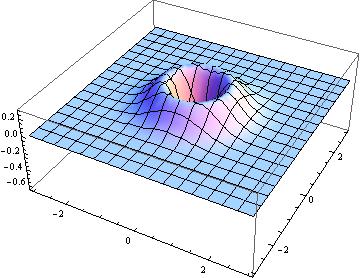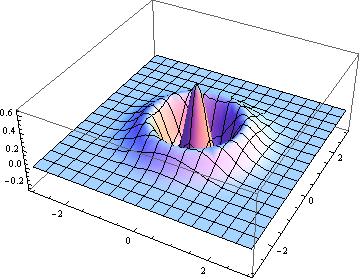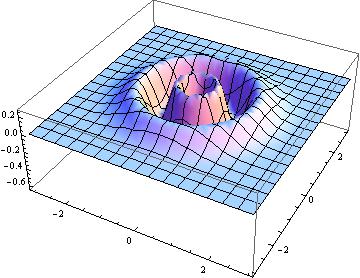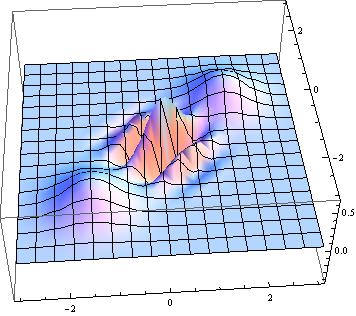Home Teaching
PHY566 Quantum Electronics II Fall 2012
(Quantum Optics and Introduction to Quantum Information)
PHY566 counts as a breadth course if your thesis research is not in atomic, optical or X-ray physics
MoWe 10:00 - 11:20AM Physics Building, S265 (note the room number)
Instructor: Tzu-Chieh Wei
Office: Math Tower 6-101
Office hour: Monday and Wednesday 11:20-11:50AM (or by appointment)
Brief description of the course:
The course is on quantum optics with some introduction to quantum
information. There is no need for the students to have taken Quantum
Electronics I. This
course focuses on the quantum properties of light. The quantized
electromagnetic field and its correlations are used to understand
nonclassical states from various sources such as two-level atoms and
nonlinear systems interacting with radiation fields. With the recent emerging
of quantum information science, physical systems from quantum optics
play an important role in real implementations of various quantum
information processing tasks and potentially a quantum computer. This
course hence also introduces ideas from quantum information, explains
how quantum computers work, and discusses how various quantum optical
systems can be used to build quantum computers.
Textbooks and references:
(1) "Quantum Optics" by Marlan O. Scully and M. Suhail Zubairy (Cambridge University Press, Dec. 1997)
(2) "Introduction to Quantum Optics: From the Semi-classical Approach
to Quantized Light" by Gilbert Grynberg, Alain Aspect, Claude Fabre
(Cambridge University Press, Dec. 2010)
(3) "Quantum Optics: An Introduction" by Mark Fox (Oxford Master Series in Physics 6, June 2006 )
(4) "Methods in Theoretical Quantum Optics" by Stephen M. Barnett and Paul M. Radmore (Clarendon Press, Oxford, 1997)
These are the main references for this course. Althougth these textbooks are not required, it is a good idea to have
one at hand. In this case either (1) or (2) will serve as a good
reference book. Lecture notes will also be posted if available.
Other references include:
(5) Prof. Bruce W. Shore visited Stony Brook and gave a series of lecture on "Coherent manipulation
of atoms using laser light" on June 12,13 & 14, 2012. One
incredible source of reference is his 243-page review article, in Acta
Physica Slovaca 58, No.3, 243-486 (2008) (243 pages) "Coherent manipulation of atoms using laser light"
as well as his book Manipulating Quantum Structures Using Laser Pulses
(Cambridge, 2011) and The Theory of Coherent Atomic Excitation (2
Volume Set).
(6) Other textbooks that include quantum optics and quantum
information: "Quantum Optics" by D. F. Walls and G. J. Milburn, and
"Modern Foundations of Quantum Optics" by V. Vedral
Other textbooks on quantum optics include
(7) "The Quantum Theory of
Light" by R. Loudon, "Atom-Photon Interactions: Basic Process and
Applications" and "Photons and Atoms: Introduction to Quantum
Electrodynamics" by C. Cohen-Tannoudji, J. Dupont-Roc, and G. Grynberg
(8) "Optical Coherence and Quantum Optics" by L. Mandel and E. Wolf
(9) "Elements of Quantum Optics" by Pierre Meystre and Murray Sargent
(10) "Principles of Laser Spectroscopy and Quantum Optics by Paul R. Berman & Vladimir S. Malinovsky
Other relevant references (incomplete):
(1) Nobel Prize in Physics 2012 (Nobel Laureates: David Wineland and Serge Haroche)
(2) "Nobel Focus: Photons at the Forefront", by Don Monroe, Phys. Rev. Focus 16, 13 (2005)
Nobel Prize in Physics 2005 (Nobel Laureates: Roy J. Glauber, John L. Hall, Theodor W. Hänsch)
(3) "The Quantum Theory of Optical Coherence", by Roy J. Glauber, Phys. Rev. 130, 2529 (1963)
(4) "Coherent and Incoherent States of the Radiation Field", by Roy J. Glauber, Phys. Rev. 131, 2766 (1963)
(5) "Equivalence of Semiclassical and Quantum Mechanical Descriptions of Statistical Light Beams", by E. C. G. Sudarshan, Phys. Rev. Lett. 10, 277 (1963).
Grades:
Homework 40%
Midterm 30%
Final Presentation 30% (Students will choose a research paper to read and report to the class)
Topics to be covered and tentative syllabus
(This is a tentative syllabus. Exam dates and due dates may change. Check here for the updated version)
(1) [Aug. 27, 29] Review and Overview: quantum harmonic
oscillator, Casimir force, Lamb shift, coherent state, Mach-Zehnder
interferometer, interaction-free
measurement, double-slit and delayed-choice measurement, one-photon and two-photon interference, Hong-Ou-Mandel
dip, atom-light interaction, polarization, entanglement (Lecture 1 & Lecture 2)
(2) (No class on Sep 3) [Sep 5] Quantization of light field (Lecture 3)
(3) [Sep 10, 12] classical and nonclassical states of light: number state, more on coherent state,
quadrature of light fields, etc. (Lecture 4 & Lecture 5)
(4) [Sep. 17, 19] Thermal state, squeezed state; density matrix (Poincare and
Bloch spheres), qubits, entangled states, etc. (Lecture 6 & Lecture 7)
(5) [Sep. 24, 26] Bell-inequality, Coherent state (P-) representation, Q-representation,
Wigner distribution, etc. (Lecture 8 & Lecture 9)
(6) [Oct. 1, 3] More on Wigner function. One-photon interference: photon detection, 1st order
coherence, Michelson
interferometer, etc. (Lecture 10 & Lecture 11)
(7) [Oct. 8, 10] Two-photon interference: 2nd
order coherence, Hanbury-Brown-Twiss interferometer, beam
splitter, polarizer, polarizing beam splitter, homodyne measurement, distinguishing polarization entangled Bell states, etc. (Lecture 12 & Lecture 13)
(8) [Oct. 15, 17] Atom-light interactions (classical field):
coupling Hamiltonians, the choice of gauge, rotating-wave approximation, Rabi oscillation, etc. Review before midterm (Lecture 14)
Oct 15: Selection of research papers to read for presentation
(9) [Oct. 22, 24] Midterm: Oct. 22. [Oct. 24] Discussions of Midterm
(10) [Oct. 29, 31] Canceled due to Hurricane Sandy
(11) [Nov. 5, 7] Bloch sphere picture, Ramsey fringes, Photon echo, 3-level systems,
Coherent Population Trapping, etc. (Lecture 15 & Lecture 16)
(12) [Nov. 12, 14] Dark states, EIT, slowed light, etc; Atom-light interactions (quantum
field):
spontaneous
emission (Weisskopf-Wigner theory), etc. (Lecture 17 & Lecture 18)
(13) (No class on Nov. 21) [Nov. 19] Jaynes-Cummings model, Cavity QED, Purcell effect, etc; (Lecture 19)
(14) [Nov. 26, 28] Basics of quantum information: quantum
teleportation, superdense coding, quantum key distribution,
entanglement, standard
circuit model of quantum computation, example quantum algorithms, error correction, one-way quantum computer, etc. (Lecture 20 & Lecture 21)
(15) [Dec. 3, 5] Student presentation
Announcement, Update and Additional Information
-Dec. 5, 2012: Today we had presentations by Arturo and Colin.
-Dec. 3, 2012: Today we had presentations by Will, Carlos and Thomas.
-Nov. 28, 2012: We discussed Grover's search algorithm, error correction, and cluster-state (one-way) quantum computation.
Next time, we will have presentations by Will, Carlos and Thomas (meet in S-141).
Lecture 21 notes are here.
-Nov. 26, 2012: Slides are due Wednesday, Nov. 28. The rest of HW4 problems are extended to noon, Dec.10.
We discussed quantum teleportation, entanglement swapping, no
cloning, BB84 and Ekert's protocols for key distribution, quantum
parallelism, and a quick overview of Shor's algorithm.
Lecture 20 notes are here.
-Nov. 19, 2012: We discussed Jaynes-Cummings model, cavity QED and Purcell effect.
Lecture 19 notes are here.
-Nov. 14, 2012: We finally got back to using quantized field to explain spontaneous emission and derived the decay rate.
Lecture 18 notes are here.
-Nov. 12, 2012: Homework 4 was distributed and is due Wed. Nov. 28. Today, we discussed dark states and EIT.
Lecture 17 notes are here.
-Nov. 7, 2012: We finished discussions of two-level atom interacting
with a clssical light field and started discussing three-level atoms,
including Coherent Population Trapping.
Lecture 16 notes are here.
-Nov. 5, 2012: We discussed the interaction picture applied to
the two-level atom interacting with a classical light field, Bloch
sphere picture, Ramsey fringes and Adiabatic Rapid Passage.
Lecture 15 notes are here.
-Oct. 31, 2012: Class canceled due to Hurricane Sandy
-Oct. 29, 2012: Class canceled due to Hurricane Sandy
-Oct. 28, 2012: "Due to the ongoing inclement weather conditions associated with Hurricane Sandy, all classes and events scheduled for Monday, October 29th, 2012, have been canceled", according to an email announcement today by Robert J. Lenahan,Chief of Police,Assistant VP for Campus Safety.
-Oct. 24, 2012: We discussed Midterm exam problems today.
-Oct. 22, 2012: Midterm
-Oct. 17, 2012: We review the
derivation of two-level atom interacting with a classical
time-dependent electric field using the Laplace transform. See lecture
14 notes. We spent the rest of class on discussing HW3 solutions.
Remember the Midterm is on Monday Oct. 22.
-Oct. 15, 2012: We dicussed
interaction of atom with (classical) light in both Coulomb gauge and
Goppert-Mayer gauge. We used the two-level atom and derived Rabi
oscillation. The mathematical tool of Laplace transform was introduced
to solve coupled differential equations.
Lecture 14 notes are here.
-Oct. 10, 2012: We dicussed HBT
experiments with a beam splitter, homodyne experiments, and
distinguishing Bell entangled states with linear optics.
Lecture 13 notes are here.
Typo in HW3: 3(a). There should be a factor exp(|\alpha|^2) on the r.h.s. of the equation for P(\alpha,\alpha*).
-Oct. 9, 2012: Nobel Prize in Physics
this year is awarded to David Wineland (Boulder) and Serge Haroche
(Paris) for their work in trapped ions and cavity QED, as well as
quantum information science; see here.
-Oct. 8, 2012: We dicussed 2nd-order
correlation and coherence
functions, understood why HBT is resilient to random phase
fluctuations, how the 2nd-order coherence reveals non-classicality of
light, and explained the function of a beam splitter, polarizing beam
splitter, and a phase shifter.
Lecture 12 notes are here.
-Oct. 3, 2012: We dicussed photon
detection and 1st-order and 2nd-order correlation and coherence
functions. We worked through some examples and gained some intution as
to when there will be intereference.
Lecture 11 notes are here.
-Oct. 1, 2012: Homework 3 was distributed today and is due Oct. 15. We dicussed more on Wigner function, derived its expression for the number state, e.g., n=1,2,3.



We also sketched how to derive the Wigner function for the cat state c (|(1.5+1.5i)> + |-(1.5+1.5i)>):

Lecture 10 notes are here.
-Sep. 26, 2012: We discussed more on P & Q representations. We
started some discussions on the Wigner function. We derived,
e.g., the P, Q, Wigner functions for a coherent state.
Lecture 9 notes are here. Homework 2 is due on Mon. Oct. 1.
-Sep. 24, 2012: We discussed CHSH-Bell inequality, P and Q representations.
Lecture 8 notes are here.
Typo in Prob 3, HW2: the 3rd line in the expression right
after "Of course, ...", there is a factor of 1/2 missing in front of
alpha*. Corrected in the online version of Homework 2.
-Sep. 19, 2012: We discussed the physical meaning of squeezing and
2-mode squeezed states and parametric downconversion. We also discussed
density matrices, Bloch and Poincare spheres, and entangled states.
Lecture 7 notes and handout are here. (Some material is in Lecture 6 notes.)
-Sep. 17, 2012: Homework 2 has been posted and distributed and due Oct. 1 (Monday)
We discussed Homework 1, thermal states (which naturally leads
to Boltzmann-Stefan law for black-body radiation), squeezed states.
Lecture 6 notes are here.
-Sep. 12, 2012: We discussed more on the coherent state, displacement
operator, and electric field quadratures and their uncertainty.
Lecture 5 notes are here.
-Sep. 10, 2012: We discussed more on quantization of light field,
derived coherent state from classical current interacting with vector
potential, derived Baker-Campell-Hausdorf forumla, and discussed some
properties of coherent state and the associated displacement operators.
Lecture 4 notes are here.
-Sep. 5, 2012: We covered quantization of light field.
Lecture 3 notes are here.
-Aug. 29, 2012: Homework 1 is now posted and due Sep. 10 (Monday)
Lecture 2 notes are here.
We discussed in class that the Casimir force can be derived using
vacuum zero point energy, but R.L. Jaffe of MIT wrote a paper on
"Casimir effect and the quantum vacuum", (http://prd.aps.org/abstract/PRD/v72/i2/e021301) in
which he derived the Casimir force from the viewpoint of relativistic
quantum forces between charges and currents.
-Aug. 27, 2012: Notes for Lecture 1 are here. (restricted access)
-Aug. 26, 2012: The classroom for PHY566 is S265, not S256.
For your information:
A brief guide to 'Student Success Resources' that are available on our campus:
https://ucolleges.stonybrook.edu/links/academic-success-resources.pdf
Americans with Disabilities Act:
If you have a physical, psychological, medical or learning disability that
may impact your course work, please contact Disability Support Services
(631) 632-6748. They will determine with you what accommodations are
necessary and appropriate. All information and documentation is
confidential.
Students requiring emergency evacuation are encouraged to discuss their
needs with their professors and Disability Support Services. For
procedures and information, go to the following web site
http://studentaffairs.stonybrook.edu/dss/
Academic Integrity:
Each student must pursue his or her academic goals honestly and be
personally accountable for all submitted work. Representing another
person's work as your own is always wrong. Faculty are required to
report any suspected instances of academic dishonesty to the Academic
Judiciary. Faculty in the Health Sciences Center (School of
Health Technology & Management, Nursing, Social Welfare, Dental
Medicine) and School of Medicine are required to follow their
school-specific procedures. For more comprehensive information on
academic integrity, including categories of academic dishonesty, please
refer to the academic judiciary website at http://www.stonybrook.edu/uaa/academicjudiciary/
Critical Incident Management:
Stony
Brook University expects students to respect the rights, privileges, and
property of other people. Faculty are required to report to the Office of
Judicial Affairs any disruptive behavior that interrupts their ability to
teach, compromises the safety of the learning environment, or inhibits
students' ability to learn. Faculty in
the HSC Schools and the School of Medicine are required to follow their
school-specific procedures.
Return to top



